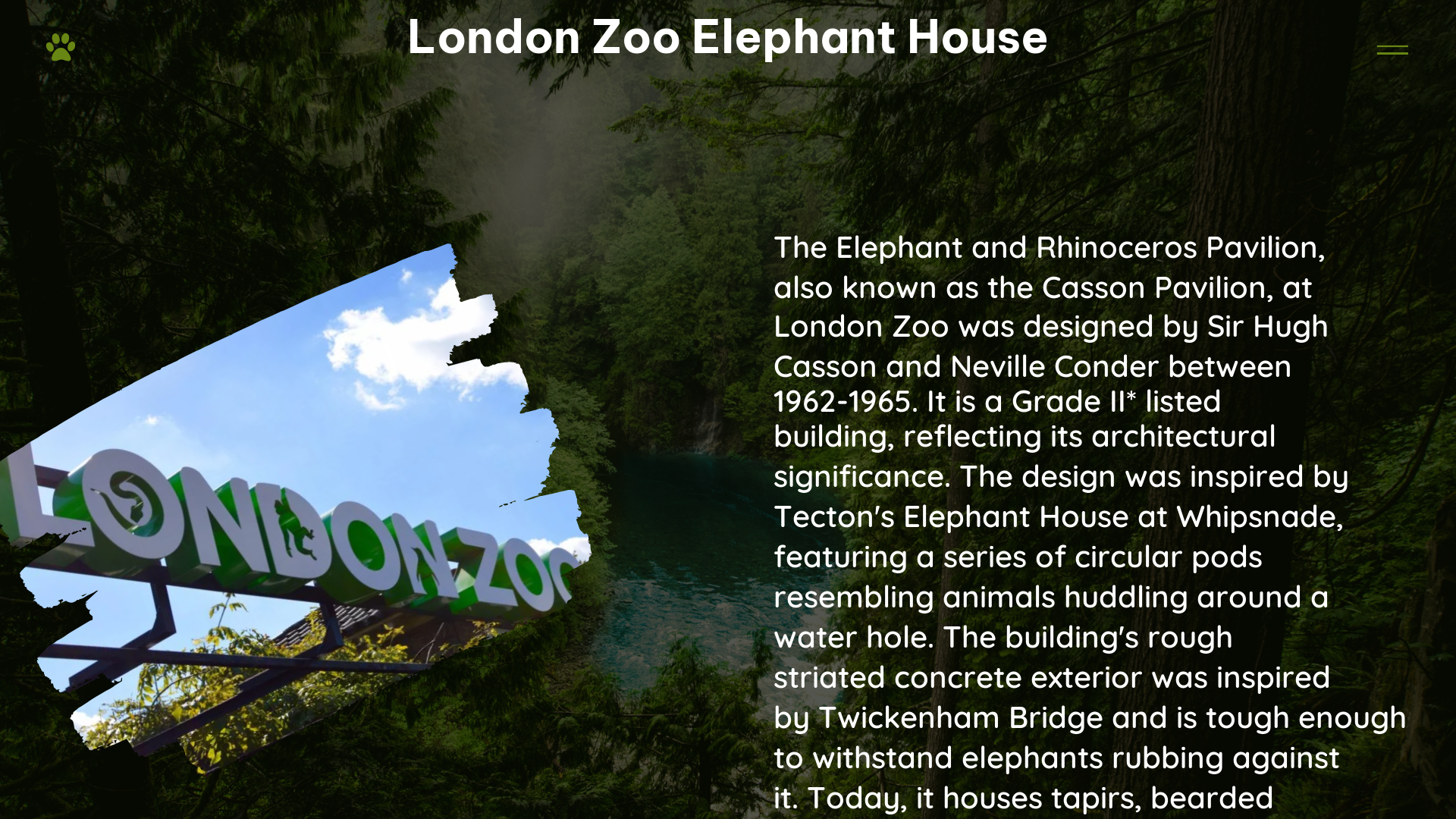The London Zoo Elephant House, also known as the Casson Pavilion, is a Grade II* listed building designed by Sir Hugh Casson and Neville Conder in 1962-65. It was built to house elephants and rhinoceroses, but all of London Zoo’s elephants and rhinos now live in more spacious accommodation at Whipsnade Wild Animal Park. The building is an excellent example of zoomorphic new brutalism, with a series of brick pens arranged about a central viewing area and clad in elephantine pick-hammered concrete.
The Architectural Design of the London Zoo Elephant House
The London Zoo Elephant House is a remarkable example of zoomorphic new brutalism, a style that seeks to mimic the natural forms and textures of the animals it houses. The building’s design features several key elements that contribute to its unique and captivating appearance:
-
Brick Pens: The animal enclosures are arranged in a series of brick pens around a central viewing area, allowing visitors to observe the animals from multiple angles.
-
Concrete Cladding: The exterior of the building is clad in pick-hammered concrete, which gives it a textured, elephantine appearance that blends seamlessly with the natural environment.
-
Conical Copper Roofs: The building’s distinctive conical copper roofs are a striking feature, resembling the shape and texture of an elephant’s skin.
-
Skylights: The pyramidal copper roofs feature skylights that provide natural, but deliberately directed, lighting to highlight the unique qualities of each animal.
The History and Evolution of the London Zoo Elephant House

The London Zoo Elephant House is part of the zoo’s rich architectural history, which includes two Grade I and eleven Grade II listed structures. These buildings reflect the changing trends and styles in architecture and methods of construction over the past two centuries.
The history of the London Zoo Elephant House also illustrates the evolution of animal husbandry. In the early 19th century, the requirements for properly caring for animals were largely unknown, but over time, the zoo has worked closely with researchers and experts from around the world to develop best practices for animal welfare.
The Current Inhabitants of the London Zoo Elephant House
While the London Zoo’s elephants and rhinos now reside at the Whipsnade Wild Animal Park, the Casson Pavilion continues to be home to a variety of other fascinating creatures. The building currently houses tapirs, bearded pigs, and other animals, providing visitors with the opportunity to learn about and observe these unique species.
Visiting the London Zoo Elephant House
The London Zoo Elephant House, or Casson Pavilion, is open to the public during the zoo’s operating hours, which are 10:00 am to 6:00 pm in the summer and 10:00 am to 5:00 pm in the winter. Adult admission to the London Zoo is £32.50, and child admission (ages 3-15) is £21.50. The zoo is located in Regent’s Park, and the nearest tube stations are Camden Town and Regent’s Park.
Conclusion
The London Zoo Elephant House, or Casson Pavilion, is a captivating architectural marvel that showcases the evolution of animal husbandry and the zoo’s rich history. Its unique design, featuring zoomorphic new brutalism elements, makes it a must-see attraction for any visitor to the London Zoo. Whether you’re a fan of architecture, animal welfare, or simply seeking a fascinating and educational experience, the London Zoo Elephant House is sure to leave a lasting impression.
References:
– The Elephant Building at London Zoo
– Elephant Enclosures at London and Whipsande Zoo
– Listed Buildings and Architecture at London Zoo
– History of London Zoo: Architecture
– Elephant Building: Heritage Highlights
